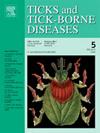莱姆病细菌在其蜱媒介中的两性二态性——肩胛骨伊蚊幼虫中,雌性伯氏疏螺旋体的丰度高于雄性
IF 3.4
2区 医学
Q2 INFECTIOUS DISEASES
引用次数: 0
摘要
在北美,蜱传播的螺旋体伯氏疏螺旋体(ss)引起莱姆病,并由黑腿蜱,肩胛骨蜱传播。伯氏疏螺旋体的获取和传播发生在吸血过程中,由三个蜱虫阶段,幼虫、若虫和成虫完成。蜱体大小和吸血行为的性别差异可能影响蜱传病原体的传播。然而,性别特异性分子标记是确定未成熟蜱性别的必要条件。本研究的目的是确定蜱性别是否影响未成熟的肩胛骨蜱的伯氏疏螺旋体的获取和丰度。方法将感染伯氏疏螺旋体或感染伯氏疏螺旋体的幼虫和若虫分别饲喂于感染伯氏疏螺旋体或未感染伯氏疏螺旋体的实验小鼠,并让其蜕皮至下一阶段。采用性别特异性PCR法测定未成熟蜱和成蜱的性别。采用23S rRNA qPCR检测蜱中伯氏疏螺旋体的存在度和丰度,采用蜱钙网蛋白qPCR检测蜱组织数量。结果未成熟雄、雌肩胛骨鼠对伯氏疏螺旋体的获取无明显差异。在饱食幼虫中,雌幼虫的螺旋体负荷比雄幼虫高45.7%,且差异显著。在4周大的未喂食若虫中,雌性若虫的螺旋体负荷比雄性若虫高7.4%,但这种差异并不显著。在饱食幼虫中,蜱的钙网蛋白基因含量在两性之间相似,而在未饱食若虫中,雌蜱的钙网蛋白基因含量比雄蜱高12.6%,表明雌若虫体型较大。在成年蜱中,雌蜱比雄蜱体重更重,钙网蛋白基因含量更高,螺旋体负荷也更高。今后的研究应进一步探讨蜱的性别是否会影响蜱对其他蜱媒病原体的传播能力。本文章由计算机程序翻译,如有差异,请以英文原文为准。
Sexual dimorphism of the Lyme disease bacterium in its tick vector – Abundance of Borrelia burgdorferi is higher in female than male Ixodes scapularis larvae
Background
In North America, the tick-borne spirochete Borrelia burgdorferi sensu stricto (ss) causes Lyme disease and is transmitted by the blacklegged tick, Ixodes scapularis. Acquisition and transmission of B. burgdorferi ss occur during blood feeding, which is done by three tick stages, larvae, nymphs, and adults. Sex-specific differences in tick body size and blood feeding behaviour may influence transmission of tick-borne pathogens. However, sex-specific molecular markers are needed for sex determination of immature ticks. The objective of this study was to determine whether tick sex influences the acquisition and abundance of B. burgdorferi ss in immature I. scapularis ticks.
Methods
Uninfected or B. burgdorferi-infected larvae and nymphs were fed on B. burgdorferi-infected or uninfected lab mice and allowed to moult into the next stage. The sex of immature and adult ticks was determined using sex-specific PCR. The presence and abundance of B. burgdorferi in ticks were determined using 23S rRNA qPCR, and the amount of tick tissue was determined using tick calreticulin qPCR.
Results
There was no difference in acquisition of B. burgdorferi between immature male and female I. scapularis. In engorged larvae, the spirochete load was 45.7 % higher in female larvae compared to male larvae, and this difference was significant. In 4-week-old unfed nymphs, the spirochete load was 7.4 % higher in female nymphs compared to male nymphs, but this difference was not significant. In engorged larvae, the tick calreticulin gene content was similar between the sexes, whereas in unfed nymphs, the calreticulin gene content was 12.6 % higher in females than males, suggesting that female nymphs are larger. In adult ticks, female ticks weighed more, had higher calreticulin gene content, and higher spirochete loads than adult male ticks. Future studies should investigate whether tick sex influences the vector competence of Ixodes ticks for other tick-borne pathogens.
求助全文
通过发布文献求助,成功后即可免费获取论文全文。
去求助
来源期刊

Ticks and Tick-borne Diseases
INFECTIOUS DISEASES-MICROBIOLOGY
CiteScore
6.90
自引率
12.50%
发文量
185
审稿时长
6-12 weeks
期刊介绍:
Ticks and Tick-borne Diseases is an international, peer-reviewed scientific journal. It publishes original research papers, short communications, state-of-the-art mini-reviews, letters to the editor, clinical-case studies, announcements of pertinent international meetings, and editorials.
The journal covers a broad spectrum and brings together various disciplines, for example, zoology, microbiology, molecular biology, genetics, mathematical modelling, veterinary and human medicine. Multidisciplinary approaches and the use of conventional and novel methods/methodologies (in the field and in the laboratory) are crucial for deeper understanding of the natural processes and human behaviour/activities that result in human or animal diseases and in economic effects of ticks and tick-borne pathogens. Such understanding is essential for management of tick populations and tick-borne diseases in an effective and environmentally acceptable manner.
 求助内容:
求助内容: 应助结果提醒方式:
应助结果提醒方式:


